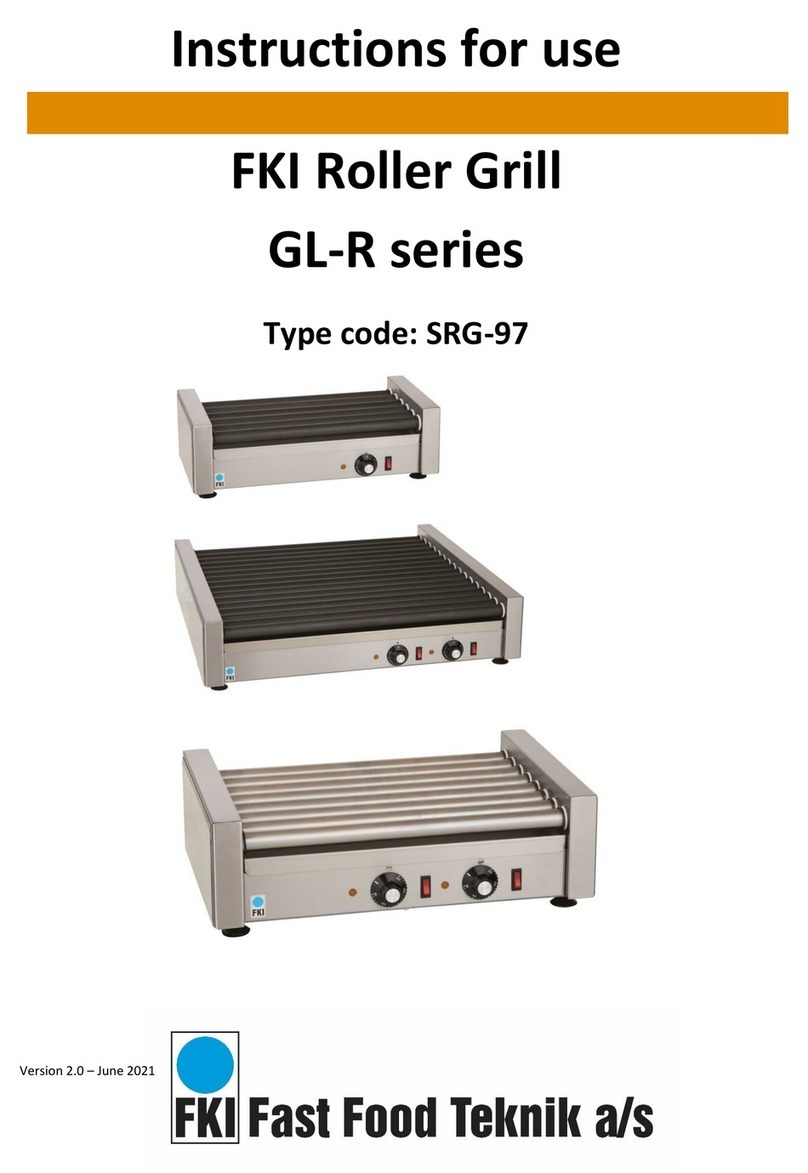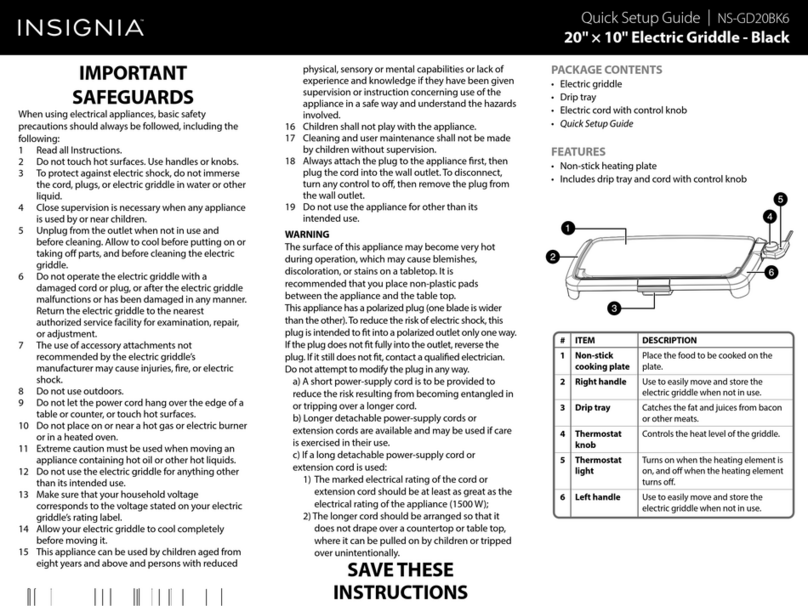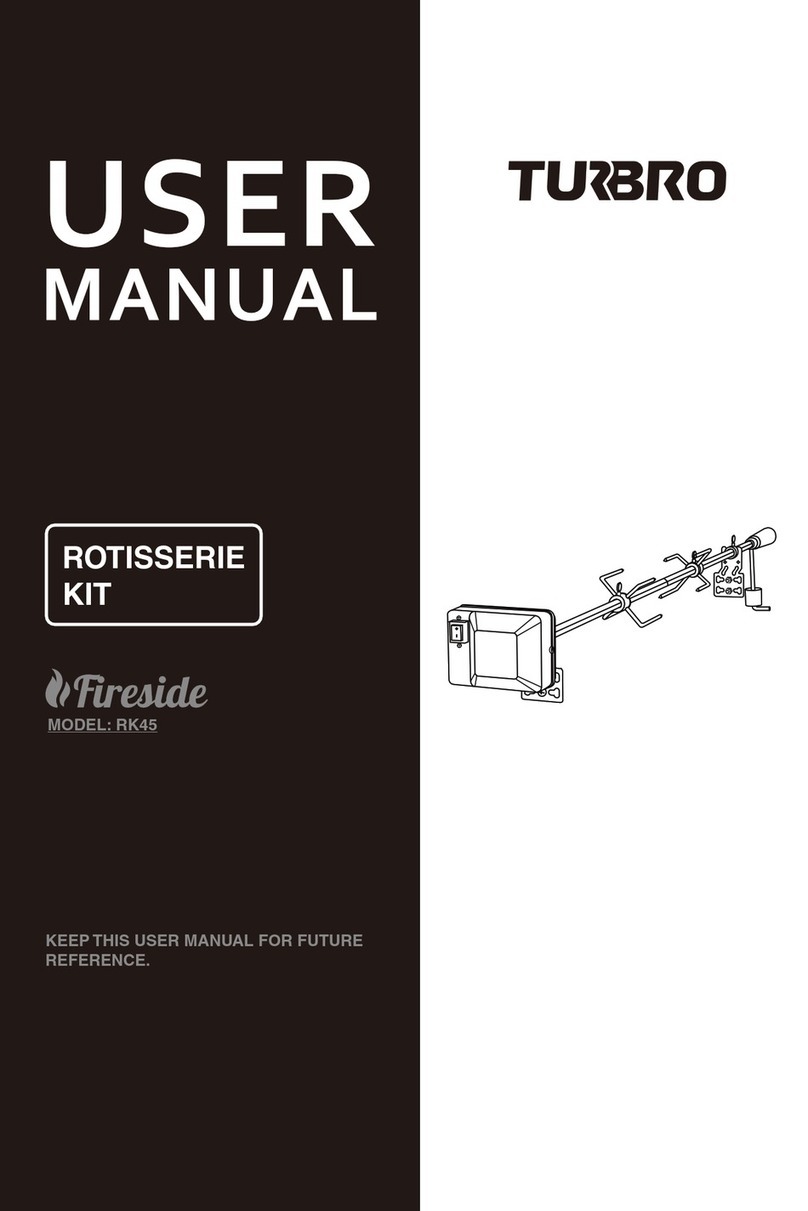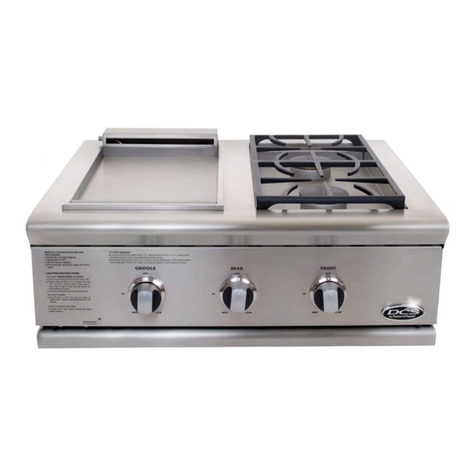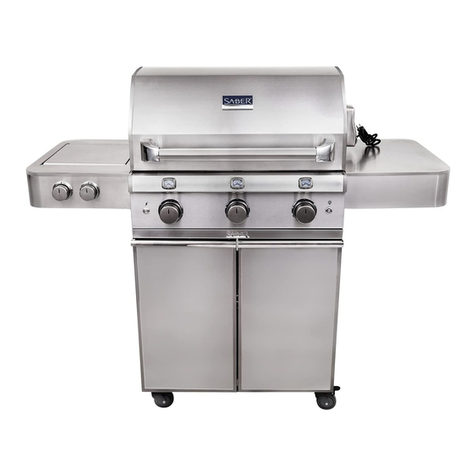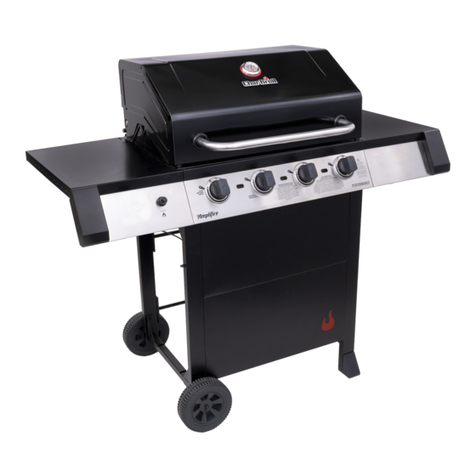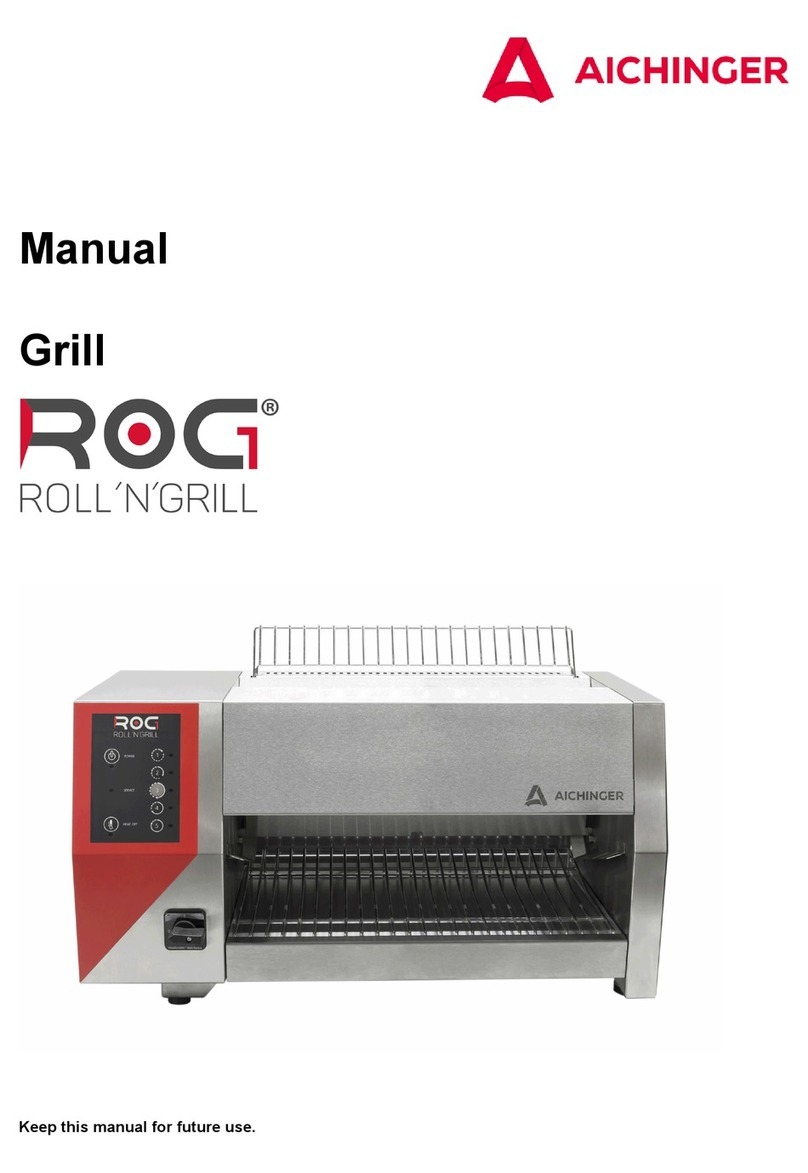Flame-Broil 5454 Installation instructions

Manufactured by
K & W Mfg. Co. Inc., Corona, California
Installation & Operation Instructions
For Gas Barbecues Models 5454 and 5458

This page intentionally blank

Page 1
A Note to You
ThankyouforbuyingaFlame-Broilbarbecuegrill. Toensurethatyouenjoyyourbarbecueequipmentformanyyears,
we developed these instructions. They contain valuable information about how to install, operate and maintain your
barbecueequipment. Pleasereadthem carefully.
Keepthisbookletandyoursalesreceipttogetherina safe place for futurereference. Itisimportantfor you to save your
salesreceipt showing the dateof purchase. Proof of purchasewill assure you ofwarranty service.
If you need assistance or service, you can reach us at:
K & W Mfg. Co., Inc.
23107 Temescal Canyon Road
Corona CA 92883-5045
Phone:951-277-3300
FAX:951-277-2070
www.k-and-w-mfg.com
Happy Barbecuing!
Limited Warranty
K & W Mfg. Co., Inc. warrants Flame-Broil Barbecue Equipment to be free from defects in design, materials, and
workmanship at the time of manufacture.
For a period of five (5) years following purchase, K & W Mfg. Co., Inc. will repair or replace, at the discretion of
K & WMfg. Co., Inc.,any Flame-Broil Barbecueunit found to be defective by K & W Mfg. Co., Inc. or their authorized
representative. This warranty does not cover the normal wear and tear that occurs from operation of the unit, nor
does it including neglect or abuse. The Flame-Broil Barbecue unit must be installed and operated in accordance
with the installation and operating instructions of K & W Mfg. Co., Inc., and any local area building and fire codes.
K & W Mfg. Co., Inc. shall not be responsible for any indirect, incidental, or other damage.
In order claim remedy under the five-year warranty, the unit must be returned to the factory, at the owner’s expense,
with a copy of the purchase receipt. If the unit is found to be defective, K & W Mfg. Co., Inc. will repair or replace the
unit at their discretion, and return the unit to the owner at the company’s expense.
At any time, K & W Mfg. Co., Inc. will repair or replace any Flame-Broil Barbecue unit, returned to the factory at the
owner’s cost, for a cost of no more that half of the current suggested retail price of the most similar current model.
Unpacking your Barbecue
When you unpack your barbecue unit, you should find:
The main body of the barbecue unit with the burner(s) installed
A drip tray at the bottom of the unit
A box inserted into the inner liner of the barbecue unit. This box should contain:
✔These instructions
✔Two small hex-head orifices for converting from natural gas to propane (LP).
✔Two smaller cooking grills
✔One larger briquet grate
✔Three or four bags of stainless steel Broilettes

Page 2
1 Installation
1.1 Setting up your stand or enclosure
Flame-Broil barbecue equipment may be installed in many different types of enclosures or stands. If you are
planning to build a permanent enclosure and/or change your gas plumbing, it is highly recommended that you
check with your local building department concerning building codes and permits. The following diagram will
provide you with the dimensions your equipment needs to fit its enclosure or stand.
1.1.1 Combustible Materials
Our barbecue units are intended for use in masonry or other fireproof locations. They are not insulated. They
should never be in contact with any combustible materials.
While operating your barbecue equipment, you should be at least 2 feet from any combustible house sidings. In
addition, you should never operate your barbecue equipment under a roof overhang or patio cover made from
combustible materials.
1.1.2 Drainage
Allowing water to pool in and around your barbecue equipment will increase the normal wear and tear to the
components, and lower their life expectancy. We recommend that you provide for drainage when building your
enclosure so that water will not pool underneath the barbecue, or inside the enclosure.

Page 3
1.1.3 Ventilation
Blockage of fresh airflow into and around your barbecue
equipment will cause overheating, poor combustion and
possible damage to components. There is an air space at
the bottom of the barbecue units, below the face. This air
space must remain open for your barbecue equipment to
operate properly.
Our barbecues are also designed to vent though the cooking
grill area. Therefore, air must be allowed to flow though the
top of the unit. Only use a Flame-Broil barbecue accessory
to cover the cooking grill area.
1.2 Gas Connections
Please study this connection information carefully. If you do not feel confident about making these connections
yourself, please get help from a professional plumber or gas appliance installer before proceeding.
Be sure to use pipe tape or pipe joint compound approved for gas when making your connections. Check all
connections for leaks with a soapy solution (50% water / 50% detergent) before lighting the barbecue unit for the
first time. Bubbles indicate a leak that must be repaired before proceeding.
We recommend that you remove the face of the unit for
easier access. Be sure to first remove all of the loose
components and accessories from the unit. Next, you
remove the knobs by pulling them straight out from the
valve bezel. The knobs fit tight on the valve stems. You
may need to carefully lever the knobs from their stems with
a screwdriver. Now, you need to remove the bezels.
Remove the two screws that hold each bezel to the face
with a large washer. Then, remove the four screws
retaining the face to the frame. Carefully lift the face away
from the frame.
(Occasionally, we need to add spacers between
the face and the frame to ensure that the cooking
grills will fit correctly. Be sure to save any spacers
you may find there.)
CAUTION: Propane, also known as LP, is a gas that is heavier than the surrounding air. You should not store
your propane bottle in an area that can trap any escaping gas. This means that your storage area must be
vented at the level of the base of your tank.

Page 4
1.2.1 Permanent Gas Connection
Standard 1/2 in. iron gas pipe is recommended to make the connection from your household gas supply to your
barbecue equipment. A shut-off valve in the gas line is recommended for safety and convenience. If the barbecue
unit is accessible to children, a shut-off valve with a removable key is highly recommended.
Stainless steel flexible connectors may be used for difficult locations. A 7/8 in. outside diameter connector is the
recommended size. Smaller sizes may cause a gas flow restriction. This problem is usually indicated by a whistling
sound in the gas line, and not enough heat available for cooking. The barbecue manifold will require a 1/2 in.
female end fitting.

Page 5
1.2.2 Propane (LP) Bottle Connection
You must use a fuel pressure regulator with your propane bottle because the gas is stored under pressure. We
recommend using iron gas pipe to extend outside of the body of your unit before connecting to the hose and
regulator.
1.3 Natural Gas to Propane (LP) Conversion
Your barbecue equipment normally comes from the factory
readyto use natural gas. To use propane,you need to change
the orifice on your gas valves. The orifice is on the end of
the valve opposite from the stem where the control knob
mounts.
You will need to slide the venturi air shutter from over the
orifice, and move it out of the way. Using a 1/4 inch wrench,
removethenaturalgas orifice and replace it with the LP orifice
thatcamewithyourequipment. Replace the venturi by sliding
the air shutter back over the orifice end of the valve.
CAUTION: Propane, also known as LP, is a gas that is heavier than the surrounding air. You should not store
your propane bottle in an area that can trap any escaping gas. This means that your storage area must be
vented at the level of the base of your tank.

Page 6
1.4 Adjusting the Fuel Mixture
After you have completed your gas connections, you
shouldcheck for the proper fuel andairmixture.(Please
remember to check all of the gas connections for leaks
with a 50/50 soap bubble solution.) With the face
removed, temporarily replace the control knobs. Turn
the gas on and light the BBQ. (See the lighting
instructions in the Operation section.) If the flames
burn with a slightly yellow tip, and do not lift from the
burner ports, no further adjustment is necessary.
To adjust combustion, loosen the air shutter set screw.
For excessive yellow flame, you turn the air shutter to
increase the air shutter opening. For flame that lifts off
the burner ports, you turn air shutter to decrease the
air shutter opening. After adjusting the fuel mixture,
tighten the air shutter screw.
1.5 Finishing the Installation
Now you can replace the face. (Do not forget any spacers you may have found between face and frame.)
The briquet grate goes on the first shelf above the burner(s). The briquet grate is the single grill piece.
Then, the Broilettes are laid down. Flame-Broil barbecue units are equipped with stainless steel Broilettes. No rock
is used with Broilettes. Your barbecue grill comes with sufficient Broilettes for efficient usage. It is not necessary for
the Broilettes to cover the entire briquet grate. It is only important that the areas above the flames from the burners
be covered.
Now, place the two cooking grills on the top shelf. If you purchased the oven accessory, place the oven in the top
shelf, and the two cooking grills inside the oven.
You are ready to barbecue.

Page 7
2 Operation
2.1 Lighting the Burner(s)
Your barbecue is equipped with two gas control valves with
built-in ignitors. Each valve is operated with its own knob on
the face. The knobs are labeled “OFF” at the twelve o’clock
position, “HIGH” at the three o’clock position and “LOW” at the
six o’clock position.
The gas control knob is operated by depressing the knob and
turning towards the “HIGH” position. It is important to depress
before turning the knob. The knob can be damaged by turning
it without first depressing it. Turning the knob towards the
“HIGH” position will start the gas to flow to the burner. When
the knob reaches the “HIGH” position, the built-in ignitor will
generate a spark (making a snapping sound), and the spark
will light the gas. After the knob is in the “HIGH” position, the
knob can be turned freely between “HIGH” and “LOW”. To
shut the gas off, depress the knob while it is in the “HIGH”
position, and turn to the “OFF” position. Again, it is important
to depress the knob before turning to avoid damaging the knob.
2.1.1 To light the burner
Depress the knob in the “OFF” position, and slowly turn the knob towards the “HIGH” position. It is helpful allow the
gas a little time to flow from the valve to the burner before reaching the “HIGH” position. When the knob reaches the
“HIGH” position, the built-in ignitor will generate a spark (making a snapping sound), and the spark will light the gas.
If the burner does not light, turn off the gas. Allow any gas to dissipate for a few minutes. Repeat this lighting
procedure. If the unit still does not light, use the troubleshooting section on lighting. If you have determined that the
ignitor is not functioning, you may use a match for lighting until you have a chance to clean ignitor or replace the
valve.
2.1.2 To light the burner with a match
Strike the match first. Drop the lit match into the unit, close to the burner’s edge. Make sure the match stays lit,
and turn the knob to the “HIGH” position. The burner should light within 5 seconds of turning on the gas. If the
burner does not light, turn off the gas. Use the troubleshooting section to check for an obstruction in your gas
supply. If you still cannot light the burner, please contact us for help.
2.2 Adjusting the Flame
The highest flame setting is with the gas control knob set at the “HIGH” position. To adjust to a lower flame, depress
the gas control knob and turn counterclockwise. The lowest flame setting is at the “LOW” position. The flame will
adjust between these two settings.
To turn off the flame, depress the gas control knob and turn clockwise to the “OFF” position.
CAUTION: Do not leave your barbecue equipment unattended after the burner has been lit.
Most fires and accidents occur when the unit has been left unattended while the flame is burning.

Page 8
2.3 Troubleshooting
Here are some of the common problems that sometimes occur with gas barbecue equipment. If these solutions do
not solve your problem, please contact us for help.
2.3.1 It won’t light.
There are two possible reasons for the unit not to light.
a) The ignitor isn’t sparking.
With the gas shut off, watch the electrode tip while
turning the knob to the “HIGH” position. It may be
necessary to use a small hand mirror to see the
electrode tip. A spark should jump from the
electrode tip. If there is no spark, follow the
maintenance procedure for the ignitor.
b) The gas is not reaching the ignitor or the burner(s).
Thereis an obstructionsomewhereinthe gas supply.
Check that the source of your gas supply is
turned on at your shut-off valve or your
propane bottle.
Check for any blockage of the gas control
valve, or the venturi and burner. Follow the maintenance procedure on cleaning the valves, venturis and
burner(s).
Check for any restriction in your gas supply lines. A common problem is to use a pipe or flexible
connector with a smaller diameter than recommended when installing the gas connections. Review the
gas connection instructions in the Installation section.
2.3.1 It won’t get hot.
a) The LP gas valve orifices are being used when the barbecue
equipment is burning natural gas.
The table on the left gives the drill size of the holes in the
orifices. If you do not have a drill set to test your orifices,
try comparing all of the orifices that came with your
equipment. The hole in the natural gas orifices is larger
than the hole in the LP orifices. If your barbecue equipment
is burning natural gas, the orifices with the larger holes
should be installed in the gas control valves.
b) An obstruction is partially blocking the gas supply to the
burner(s).
Check that the source of your gas supply is turned on at
your shut-off valve or your propane bottle.
Check for any blockage of the gas control valve, or the
venturi and burner. Follow the maintenance procedure
on cleaning the valves, venturis and burner(s).
Check for any restriction in your gas supply lines. A
common problem is to use a pipe or flexible connector with a smaller diameter than recommended when
installing the gas connections. Review the gas connection instructions in the Installation section.

Page 9
2.3.1 It gets too hot.
The natural gas valve orifice is being used when the barbecue
equipmentisburningLP (propane)gas. Thetableonthe leftgives
the drill size of the holes in the orifices. If you do not have a drill
set to test your orifices, try comparing all of the orifices that came
with your equipment. The hole in the natural gas orifices is larger
than the hole in the LP orifices. If your barbecue equipment is
burningLP (propane) gas, the orifices withthesmallerholesshould
be installed in the gas control valves.
2.3.2 There is a whistling noise.
There is a restriction in your gas supply lines. A common problem
is to use a pipe or flexible connector with a smaller diameter than
recommended when installing the gas connections. Review the
gas connection instructions in the Installation section.
2.3.3 Flames around the gas control knob panel.
This is known as a flashback fire. There is an obstruction in the
venturi and/or the burner. This obstruction causes gas to back up and escape out the venturi air shutter where it
ignites when you light the unit. Follow the maintenance procedure on cleaning the burner(s) and venturis.

Page 10
3 Maintenance
Periodicinspectionandcleaning of your barbecue equipment will ensureitsproperoperation. The following checklist
is recommended.
Clean the cooking grills, broilettes and briquet grate.
Clean the burner(s), venturis and valves.
Clean the grill interior.
Check the ignitor.
Reassemble and test.
If you live in an area where inclement weather prevents you from using your barbecue equipment during certain
times of the year, it is a good idea to remove and store the unit. This practice will extend the life of your equipment
and its components. If you cannot remove the unit, try to cover it completely from the elements.
3.1 Preparation
Always shut off the gas supply at the source before doing any maintenance or repairs.
Many parts will have a greasy film or rusty residue. Wear protective clothing and protect the area around the
barbecue equipment.
Before removing any components, have a notebook handy to keep notes on the order and placement of the parts.
You will need:
3.2 Clean the Cooking Grills, Broilettes and Briquet Grate
Cooking grills are most efficiently and easily cleaned on an ongoing basis by
simply pre-heating the grill on high for a few minutes before each use. After
heating, scrubbing with a brass bristle brush to remove the loose residue, and
then carefully wipe down with a wet paper towel.
Tip - Coating the cooking grills with vegetable oil before cooking helps prevent
the food from sticking and makes cleaning easier.
Fora thorough cleaning, remove andinspect the cooking grills. If youfind broken
welds or excessive rust, you may opt to replace the grills. If the cooking grills are
not too badly deteriorated, soak in a hot soapy water solution to loosen
accumulated grease (a degreaser may also be used), then scrub with a steel
wool pad or a stiff nylon pad. Rinse thoroughly and lightly coat with vegetable oil before use.
Next, remove and inspect the stainless steel Broilettes. Any badly deteriorated ones
should be replaced. A light coating of rust is okay. Knock off any loose rust or
deposits with a wire brush. You may wash them if you desire.
Finally,inspect the briquetgrate.Thiscomponentis subject to very hightemperatures
andwillweakenand deteriorate over time. If the grate is very thin, or sags excessively,
replace it with a new grate. Otherwise, knock off any loose rust and scale with a wire
brush.
Bucket or small tub
Wire brush
Steel wool or nylon pad
Fine sandpaper or emery cloth
Toothpick or small piece of wire
Philips screwdriver
1/4 inch wrench
Putty knife or scraper
Strong detergent or degreaser
Rubbing Alcohol
Vegetable oil
WD40 or similar lubricant
Venturi spider brush (optional)

Page 11
3.3 Clean the Burner(s) and Venturis
Atthispoint, you should remove thefaceof the unit for easier
access. Remove the knobs by pulling them straight out from
the valve bezel. The knobs fit tight on the valve stems. You
may need to carefully lever the knobs from their stems with a
screwdriver. Now, you need to remove the bezels. Remove
the two screws that hold each bezel to the face with a large
washer. Then, remove the four screws retaining the face to
the frame. Carefully lift the face away from the frame.
(Occasionally, we need to add spacers between the face
andtheframetoensurethat the cooking grills will fit correctly.
Be sure to save any spacers you may find there.)
Carefully remove the burner(s) from the inner lining area.
With the model #5458, you may need to pry back the clips
that hold the burners to the liner. Lightly brush the burner
with a wire brush to remove loose rust and scale. Inspect
the burner for holes or split seams, and replace if necessary.
If the burner passes inspection, next inspect the venturi.
IT IS EXTREMELY IMPORTANT to clean the venturi
tubes of any obstructions, such as spider or insect webs,
etc. A small web can block the gas flow and cause poor
burner performance or a flashback fire. A flexible spider
brush is the best tool for cleaning the venturi tubes.
Special care should be taken to make sure the brush
passes through the entire venturi tube, all the way to the
burner.
If a spider brush is not available, you may flush out the
venturi with a strong flow of water from a garden hose.
Pay special attention to how the water exits the burner
portholes, as clogged holes are easilyspotted. Clogged
holes can be opened with an awl or piece of wire.
Clogged holes can cause a grill to have hot and cold
spots because of uneven flame characteristics.
3.4 Clean the Valves and Ignitors
The valves can now be checked. Temporarily slide the valve
knobs back onto the valve stems. The knobs should depress,
turn and release (pop up) freely. If they are sluggish, carefully
spray a small amount of WD40 or similar lubricant onto the
valve stem area. Work knobs a few times to distribute the
lubricant. Valves that bind severely should be replaced.
Small insects can also block the valve orifice, which will restrict
gas flow. Debris in the gas supply lines may also clog these
tiny holes. So, remove the hex head orifice with a 1/4 inch
wrench, and make sure the hole is completely clean. Also,
check the inner portion of the valve from where the orifice was
removed. Debris can be removed with a small piece of wire or
toothpick. Re-install orifices and tighten.

Page 12
Each valve is equipped with an ignitor. As the valve knob
is turned from “OFF” towards “HIGH”, gas is released into
thecollectiontube. When the knob reaches “HIGH”,a high
voltage sent along the spark wire to the electrode tip. A
spark from the electrode tip lights the gas in the collection
tube.
Grease,dirt and/or rust on theelectrode tip or the collector
tube can prevent the sparking. Clean any dirt and grease
with alcohol. Remove any rust by lightly sanding with
emery cloth or fine sandpaper.
Checkthattheelectrodeinsulation isn’t cracked or broken.
Check the spark wire for abrasions, cuts or burns in the
insulation. The valve will need to be replaced to correct
these problems.
Testthesparkingby turning theknobfrom“OFF”to“HIGH”
while watching the electrode tip. The spark should jump
from the electrode tip to the end of the collection tupe. It
may be necessary to use a small hand mirror to watch the
spark.
3.5 Clean the Grill Interior
First, protect the ignitor electrode tip where it protrudes in the grill interior by covering it with a protective cloth or
plastic, or aluminum foil.
Secondly, scrape off heavy grease or cooking debris accumulation with a putty knife or scraper. You can vacuum
this debris with a shop vacuum cleaner, or brush it through the holes in the burner tray, at the bottom of the liner,
onto the drip tray. When you are done, you should remove and dump the contents of the drip tray.
Lastly, scrub the interior with a strong detergent solution (a degreaser may also be used). Rinse, and let dry.
Remove protective covers installed earlier.
3.6 Reassemble and Test
Reinstalltheburner(s). Slidetheventuriair shutter back
over the orifice end of the valves.
Turn on the gas supply, and test light the burner(s).
Review the section on adjusting the fuel mixture, and
check your flame.
Now you can replace the face. (Do not forget any
spacers you may have found between face and frame.)
Replace the briquet grate and the broilettes. Distribute
the broilettes evenly in the areas on the briquet grate
surface above the flames from the burners. This will
help the grill cook at an overall even temperature.
Finally, you can replace the cooking grills. If you
purchased the oven accessory, place the oven in the
top shelf, and the two cooking grills inside the oven.

Page 13
4 Replacement Parts Lists
4545ledoM
#traPnoitpircseDytQ
921-0545etarGteuqirB1
3245kcaP21,setteliorB3
800-3545ylbmessArenruB1
700-0545yarTpirD1
721-4545saG,bonK2
131-4545saG.P.L,ecifirO2
231-4545saG.taN,ecifirO2
331-4545saG.P.L,evlaV2
031-4545saG.taN,evlaV2
02555.11x61emorhC,llirG2
8545ledoM
#traPnoitpircseDytQ
921-5545etarGteuqirB1
3245kcaP21,setteliorB4
800-5545ylbmessArenruB2
700-5545yarTpirD1
721-4545saG,bonK2
131-8545.P.L,ecifirO2
231-8545.taN,ecifirO2
331-8545saG.P.L,evlaV2
031-8545saG.taN,evlaV2
125551x81emorhC,llirG2

This manual suits for next models
1
Table of contents
Popular Grill manuals by other brands
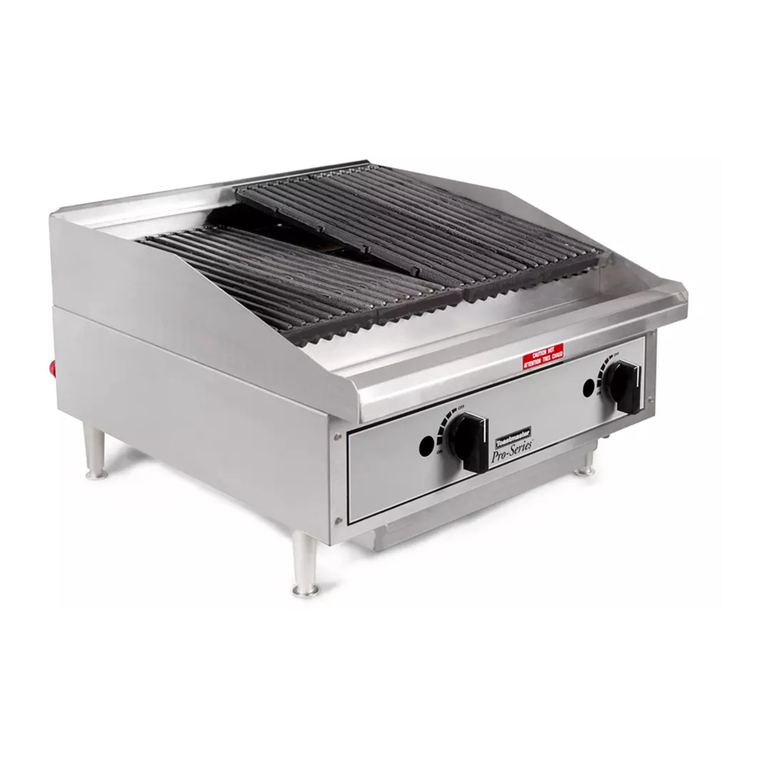
Toastmaster
Toastmaster Radiant TMRC24 Installation and operation instructions
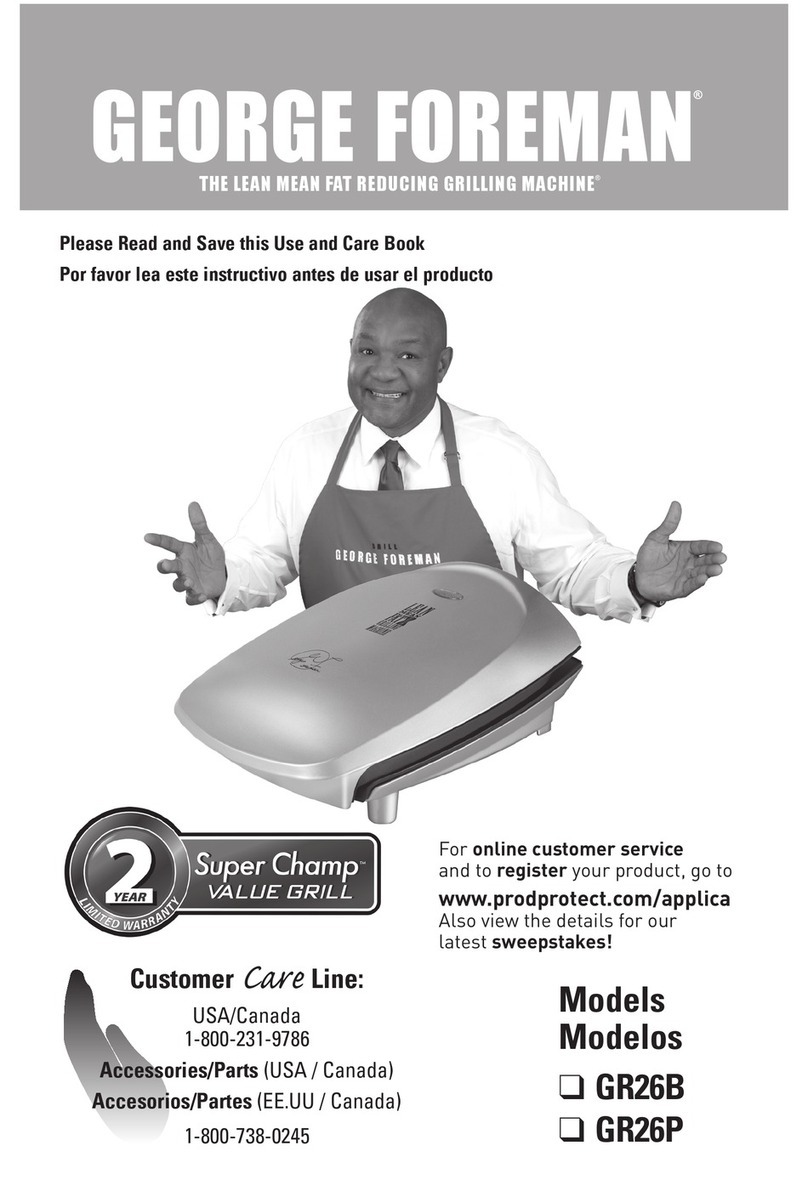
George Foreman
George Foreman GR26B Super Champ use and care manual
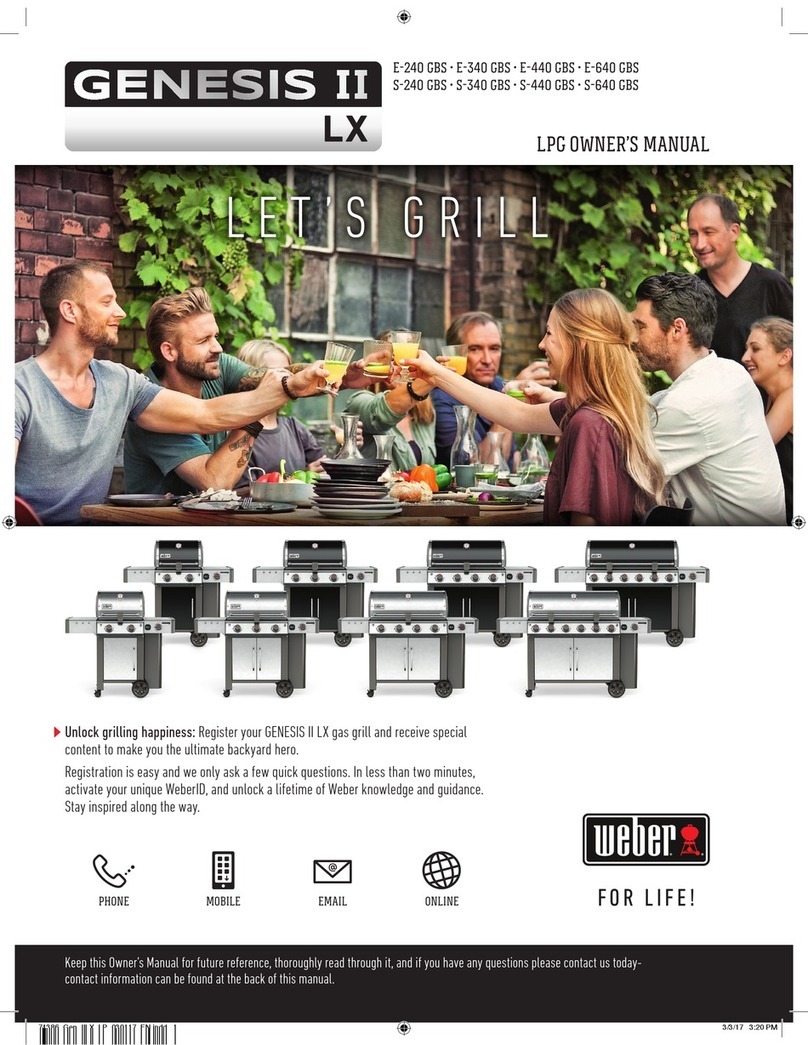
Weber
Weber E-240 GBS owner's manual
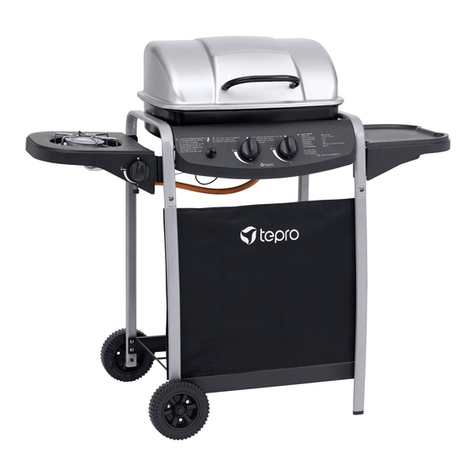
tepro
tepro Fremont Assembly and operating instructions
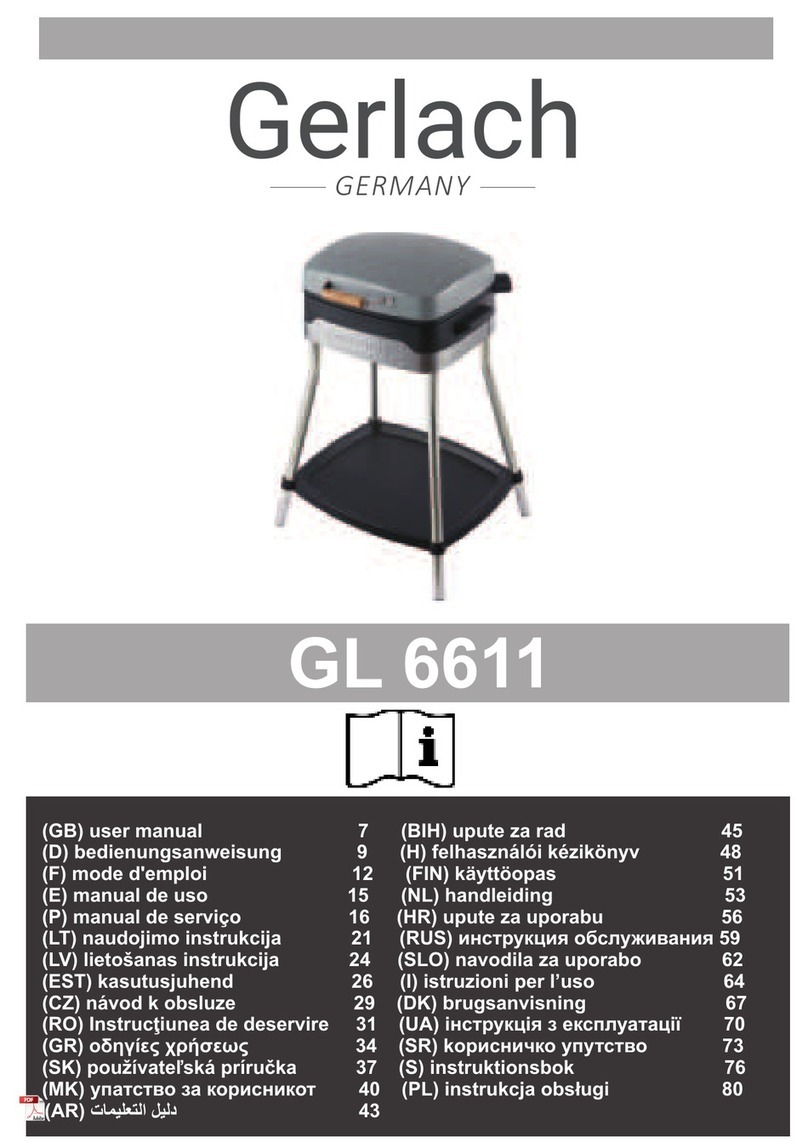
Gerlach Germany
Gerlach Germany GL 6611 user manual

Nexgrill
Nexgrill 720-0830MG Assembly instructions


